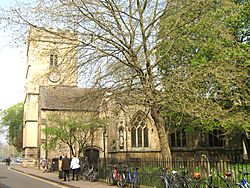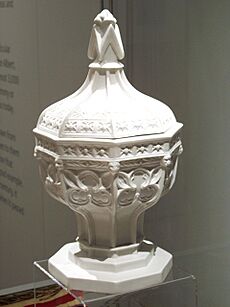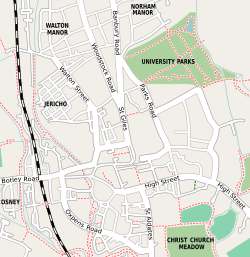St Mary Magdalen's Church, Oxford facts for kids
Quick facts for kids St Mary Magdalen |
|
|---|---|
 |
|
| 51°45′17″N 1°15′32″W / 51.754620°N 1.258826°W | |
| Location | Magdalen Street, Oxford |
| Country | England |
| Denomination | Church of England |
| Churchmanship | Anglo-Catholic |
| History | |
| Dedication | Mary Magdalene |
| Architecture | |
| Functional status | active |
| Heritage designation | Grade I listed |
| Designated | 12 January 1954 |
| Architect(s) |
|
| Style | Gothic, Gothic Revival |
| Specifications | |
| Materials | Jurassic limestone |
| Bells | 10 |
| Tenor bell weight | 7 cwt, 1 st, 12 lb |
| Administration | |
| Parish | Oxford St Mary Magdalen |
| Deanery | Oxford |
| Archdeaconry | Oxford |
| Episcopal area | Oxford Episcopal Area |
| Diocese | Diocese of Oxford |
| Province | Province of Canterbury |
St Mary Magdalen is an old and important Church of England church in Magdalen Street, Oxford, England. It is named after Mary Magdalene, who was a companion of Jesus. This church is one of Oxford's oldest parish churches. It is also a Grade I listed building, which means it is a very special historical site.
Contents
What Happens at the Church?
The church of St Mary Magdalen follows a style of worship called Anglo-Catholicism. This is a "high church" tradition, meaning it has more formal services. They hold services, called Mass, many times a week. You can attend Mass twice every weekday and three times on Sundays. The main Sunday service is at 10:30 in the morning.
A Look at History
The story of St Mary Magdalen church began a very long time ago.
Early Beginnings
Long before the stone church you see today, there was a wooden church. It was built during the Anglo-Saxon period, outside the old city walls of Oxford. Sadly, this wooden church burned down in 1074.
After the fire, a Norman leader named Robert D'Oyly built a new, single-aisle chapel. This was a simple church to replace the one that was lost.
Building and Changes Over Time
In 1194, Saint Hugh, who was the Bishop of Lincoln, had the church rebuilt. Some parts of his church are still there today. You can see parts of the east wall of the chancel (the area around the altar) and the south aisle. There was also an altar dedicated to St Thomas Becket.
By 1235, another altar was added, this one dedicated to the Virgin Mary. Later, in the late 1200s, the chancel was rebuilt again.
About a century later, students from the new Balliol College added a special prayer room. This room, dedicated to St Catherine, is now part of the north aisle. In 1320, a group called the Carmelites built a chapel in the south aisle. This chapel is still known as the Lady Chapel today.
The tall west tower of the church was built between 1511 and 1531. Around the same time, a south porch was added, which even had a room above it.
Victorian Restoration
In the 1840s, the church went through a big "restoration" project. This means it was repaired and updated.
- The north aisle, sometimes called the "Martyrs' Aisle," was worked on by two architects, George Gilbert Scott and William Bonython Moffatt. They also removed an old Norman arch. This new north aisle was designed to match the Martyrs' Memorial nearby. It was one of the first buildings in Oxford to show the new Gothic Revival style inside.
- The south aisle was restored by another architect named Edward Blore.
Later, in 1874–75, more changes were made to the 13th-century chancel. The floor was raised near the altar, and a screen was added. The windows in the west tower were opened up, and the church bells were re-hung. These changes were overseen by architect William Wilkinson.
A famous writer and historian named John Aubrey was buried in the churchyard.
Church Bells

The west tower of the church has a set of 10 bells. These bells are used for change ringing, a special way of ringing bells in a pattern. All the bells were made or re-made by a company called John Taylor & Co in Loughborough.
The largest bell, called the tenor bell, was re-made in 1988. Five other bells were re-made in 1990. Two more bells were made in 2000. For a long time, there were eight bells, but in 2001, John Taylor & Co added two new bells, making a total of 10.
Since the 1930s, the bells have been rung by the Oxford University Society of Change Ringers.
More to Explore
- Oxford University Society of Change Ringers
- St Michael at the Northgate, another historic church nearby
- St Giles' Church, located to the north of St Mary Magdalen


